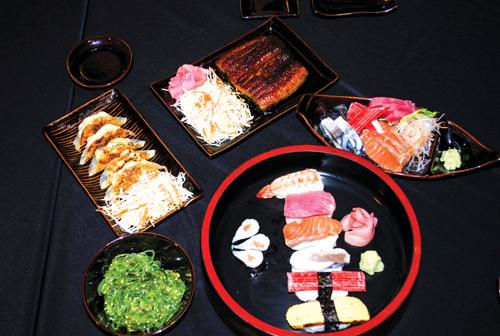A taste of Tokyo in Phuket Town

PHUKET: GINZA, located on Yaowarat road, is a relatively newcomer to the Phuket culinary scene. But within the space of just four months since it opened, the restaurant has already managed to garner quite a following. The popularity is largely due to the establishment’s strict adherence to the pillars of Japanese cuisine – the freshest and highest quality ingredients.
The shop house setting of Ginza is redolent of the busy Tokyo street it is named after. And that’s the intention of one of the restaurant co-owners, Nitichai “Yuth” Nenraksa, who lived and worked in Japan before building a career as food and beverage manager working for many top hotels in both Bangkok and Phuket.
“The tiniest of lanes in Ginza are always crammed with gems of eateries serving wonderful, freshly prepared Japanese food. I chose to establish Ginza in the old town of Phuket and hope it can recreate the same vibes,” say Yuth.
Everything about Ginza is distinctly Japanese – from the rock garden and red banners that greet guests at the door, to the black and red color palette interior, tatami covered seating (there’s room to place your legs so you don’t actually sit on the floor), and smart minimalist tableware. Recently, Ginza has extended its premises to include a shop next door, with private rooms upstairs for a more intimate dining experience.
A quick glance at the menu reveals a rich picking of appetizers and I highly recommend: Cold tofu (silky bean curd topped with soy sauce, spring onions, ginger and dried fish flakes), octopus and cucumber salad (made with tentacles only, and is not for the squeamish), salmon roe with radish, and spicy chilled seaweed. All the hors d’oeuvres are refreshingly light, a great filler to pick through and prepare your palette for the more substantial things to come.
As we sip the chilled nama sake (a kind of draught sake with round and fresh aftertaste), a plate of mixed sashimi arrives. Making up the combo are hamachi (yellowtail), maguro (yellow fin tuna), salmon, saba (mackerel from Finland), octopus slices and red snapper. All fish slices are served fresh, except for the saba, which is lightly pickled in rice vinegar, and the lightly blanched octopus slices or taka.
You may want to sample unagi, soy sauce smoked eels, which comes directly from Hamamatsu City in Nagoya, a place renowned for the best Unagi found anywhere in Japan. Unagi is made by grilling freshwater eel slowly over charcoal while sprinkling it with sweet soy sauce, the process produces crisp unagi with the most flavorsome tender flesh inside.
“Unagi is a delicacy that is associated with good luck and longevity,” explains Yuth, who is a mine of knowledge when it comes to Japanese food.
If you need a little more “fillers” then sushi is your next choice. Here at Ginza the selection is endless, and you can choose from the basic nigiri mariawase (mixed sushi) and the more fancy futomaki, to the popular California rolls; a concoction made with vinegared rice, shrimps, avocado and asparagus, among many other choices.
There’s also a set menu for those lunching between working hours, that include a choice of grilled saba, tempura (battered prawns), ramen (noodles), katsu kare (pork with curry). All dishes are served with rice, pickle and miso soup, at a very reasonable price of 140 baht, with only additional 20 baht for either coffee or green tea.
Go to Ginza to experience authentic and superior Japanese food in a cozy setting and a friendly service. Call in advance so you can chat with Yuth who will show you how to drink chilled matsu sake with a pinch of salt from a square wooden cup. He may even fill you in with the virtue of sweetness in Japanese food. His enthusiasm and knowledge will surely add another dimension to your dining experience.
— Nanthapa Pengkasem
Latest Thailand News
Follow The Thaiger on Google News:


























